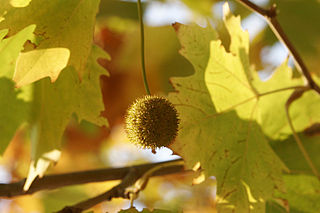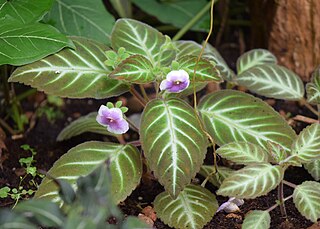
Platanaceae, the "plane-tree family", is a family of flowering plants in the order Proteales. The family consists of only a single extant genus Platanus, with eight known species. The plants are tall trees, native to temperate and subtropical regions of the Northern Hemisphere. The hybrid London plane is widely planted in cities worldwide.

Platanus is a genus consisting of a small number of tree species native to the Northern Hemisphere. They are the sole living members of the family Platanaceae.

Maianthemum includes the former genus Smilacina and is a genus of perennial herbaceous flowering plants with fleshy, persistent rhizomes. It is widespread across much of North America, Europe and Asia, and may be terrestrial, aquatic or epiphytic. It is characterized by simple, unbranched stems that are upright, leaning or hanging down and have 2–17 foliage leaves. Leaves are simple and may clasp the stem or be short-petiolate. The inflorescence is terminal and either a panicle or a raceme with few to many pedicelate flowers. Most species have 6 tepals and 6 stamens; a few have parts in 4s. Tepals are distinct in most species and all of similar size. Flowers are spreading, cup-shaped or bell-shaped and usually white, but lavender to red or green in some species. Fruits are rounded to lobed berries containing few to several seeds.

Woodwardia is a genus of ferns in the family Blechnaceae, in the suborder Aspleniineae of the order Polypodiales. Species are known as chain ferns. The genus is native to warm temperate and subtropical regions of the Northern Hemisphere. They are large ferns, with fronds growing to 50–300 cm long depending on the species. The fossil record of the genus extends to the Paleocene.

Linnaea is a plant genus in the honeysuckle family Caprifoliaceae. Until 2013, the genus included a single species, Linnaea borealis. In 2013, on the basis of molecular phylogenetic evidence, the genus was expanded to include species formerly placed in Abelia, Diabelia, Dipelta, Kolkwitzia and Vesalea. However, this is rejected by the majority of subsequent scientific literature and flora.

Tournefortia, commonly known as soldierbush, is a genus of flowering plants in the borage family, Boraginaceae.

Martin Martens was a Belgian botanist and chemist born in Maastricht, Netherlands.

Cologania is a genus of flowering plants in the legume family, Fabaceae. It belongs to the subfamily Faboideae.
Galium geminiflorum, the twinflowered bedstraw, is a plant species in the Rubiaceae, currently accepted as a distinct species. This 1838 name by Lowe should not be confused with the 1844 plant given the same name by Martens & Galeotti.

Quercus insignis is a Mesoamerican species of oak in the white oak section, within the beech family. It is native to southern Mexico and Central America, from Veracruz to Panamá.

Smithiantha, sometimes referred to as temple bells, is a genus of flowering plants in the family Gesneriaceae, endemic to southern Mexico, primarily in Oaxaca state.

Vesalea is a plant genus in the honeysuckle family Caprifoliaceae. They are native to Mexico.
Gyrandra is a genus of flowering plants in the family Gentianaceae, found in Texas, Mexico and Central America. Annual herbs, they are usually found in montane pine-oak forests.
Amphibologyne is a genus of flowering plants belonging to the family Boraginaceae.
Cyphomeris is a genus of flowering plants belonging to the family Nyctaginaceae.

Gloxinella is a monotypic genus of flowering plants belonging to the family Gesneriaceae. It only contains one species, Gloxinella lindeniana(Regel) Roalson & Boggan

Eucodonia is a genus of flowering plants belonging to the family Gesneriaceae.

Lamourouxia is a genus of flowering plants belonging to the family Orobanchaceae.

Platanus rzedowskii, commonly known as Rzedowski's plane tree, Rzedowski's sycamore, Sicómoro de la Sierra Madre Occidental, or the Sierra Madre Occidental sycamore, is a species of Platanus in the family Platanaceae. It was described by Jackie M. Poole in 2003 with the name attributed to Kevin C. Nixon.
Platanus gentryi, commonly known as Gentry's plane tree, Gentry's sycamore,Sicómoro de la Sierra, or the mountain sycamore, is a species of Platanus in the family Platanaceae. It was described by Kevin C. Nixon and Jackie M. Poole in 2003. The species is endemic to northwestern Mexico, primarily the states of Chihuahua, Sinaloa, and Sonora, at general elevations of 650–1,500 m, where it grows in semi-arid, dry conditions. It is currently listed as "Vulnerable" by the IUCN Red List, for the logging industry has been over-exploiting the species profitable lumber.














